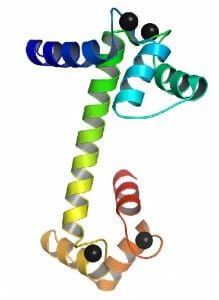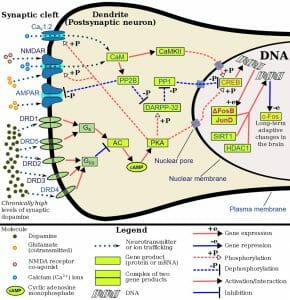Calmodulin Definition
Calmodulin, or calcium-modulated protein, is a calcium-binding protein found in the cytoplasm of all eukaryotic cells. It interacts with many other proteins in the cell, and acts as a regulator or an effector molecule in a wide variety of cellular functions. These functions include things as diverse as regulation of the cell cycle, intracellular signalling, fertilization, and muscle contraction. Calmodulin is in a family of proteins along with troponin C, another essential calcium-binding protein involved in muscle contraction. Calmodulin is an essential protein; mutations to any of the calmodulin-encoding genes or damage to the calmodulin binding sites often proves lethal.
Calmodulin Structure
Calmodulin is a protein made up of 148 amino acid residues. It is encoded by multiple genes; in humans: CALM1, CALM2, and CALM3 which are found on chromosomes 14, 2, and 19, respectively. Calmodulin forms two globular domains connected by a flexible central linker. Each domain binds two calcium ions in E-F hand motifs, a motif ubiquitous in calcium-binding proteins, so that calmodulin can bind a total of four Ca2+ ions. The calcium binding sites are 12 amino acids long and contain many negatively-charged or polar amino acid residues such as aspartate, glutamate, and asparagine. The side chains on these amino acids form ionic bonds with the Ca2+ ions. Other amino acid residues with side chains rich in oxygen atoms also attract the calcium cations. This promotes binding even at very low concentrations of Ca2+.
When calcium is bound to calmodulin a helix-loop-helix is formed along the backbone and a conformational change occurs. This conformational change, coupled with the flexibility of the protein due to the flexible connecting linker, allows calmodulin to interact with and bind to a wide variety of other proteins.

This figure depicts the structure of calmodulin with four calcium ions bound.
Calmodulin Function
Calmodulin is a ubiquitous regulator protein that is involved in many calcium-mediated processes. When Ca2+ binds to calmodulin it forms the Ca2+/calmodulin complex which then interacts with other proteins in the cell. These proteins are enzymes and effector proteins involved in a variety of cellular and physiological processes. The Ca2+/calmodulin complex can also regulate processes directly.
One of the functions of the Ca2+/calmodulin complex is to activate calcium pumps. These pumps remove calcium from the cytoplasm by either pumping it out of the cell or storing it in the endoplasmic reticulum. By controlling the amount of calcium in the cell, the downstream responses are regulated.
Further examples of Ca2+/calmodulin complex function include binding to Ca2+/calmodulin kinases (CAMK) such as the myosin light chain kinase. This binding allows the CAMKs to phosphorylate effector proteins by transferring phosphates from ATP to serine and threonine residues on the receiving proteins. These proteins then go on to activate downstream processes such as intracellular signalling, smooth muscle contractions, neurotransmitter and hormone synthesis and release, and cell cycle regulation.

This figure shows an example of how calmodulin (CaM) can be involved in a complex pathway in a post-synaptic neuron. The pathway shown here is the KEGG pathway in human drug addiction.
Calcium
It is becoming increasingly apparent that calcium plays a crucial role in a number of physiological processes. When not in use the concentration gradient of calcium ions between the inside and outside of the cell is very large; the concentration of extracellular calcium is approximately 1 mM while the concentration of free calcium ions within the cell is less than 0.1 μM. This is likely due to the fact that calcium will interact readily with many proteins.
The majority of calcium in the cell enters through gated calcium channels. It can also be stored in the endoplasmic reticulum. The calcium channels are large trans-membrane proteins that allow passage of ions into the cell when a specific stimuli is met. this usually occurs when the membrane is depolarized or a ligand is attached.
Quiz
1. Where is calmodulin located?
A. nucleus
B. plasma membrane
C. cytosol
D. outside of the cell
2. How many calcium ions can bind to calmodulin?
A. none
B. one
C. two
D. four
3. What processes is calmodulin involved in?
A. cell signalling
B. muscle contraction
C. phosphorylation pathways
D. all of the above
References
- King, R. C., Mulligan, P. K., & Stansfield, W. D. (2014 online). Oxford, UK: Oxford University Press. eISBN: 9780199376865.
- Martin, E., & Hine, R. (2008 online). Oxford, UK: Oxford University Press. eISBN: 9780191726507.
- Randall, D., Burggren, W., & French, K. (2002).Eckert animal physiology: mechanisms and adaptations, 5th. ed. Chs. 9 and 10. New York, NY: W.H. Freeman and Company. ISBN: 0-7167-3863-5.
- Weaver, R. F. (2005).Molecular biology, 3rd. ed. Ch. 24. New York, NY: McGraw-Hill. ISBN: 0-07-284611-9.
